Lassie (1954 TV series)
Lassie is an American television series that follows the adventures of a female Rough Collie dog named Lassie and her companions, both human and animal. The show was the creation of producer Robert Maxwell and animal trainer Rudd Weatherwax and was televised from September 12, 1954, to March 25, 1973. The eighth longest-running scripted U.S. primetime television series (after The Simpsons, Law & Order: Special Victims Unit, Gunsmoke, Law & Order, Family Guy, NCIS, and American Dad), the show ran for 17 seasons on CBS before entering first-run syndication for its final two seasons. Initially filmed in black and white, the show transitioned to color in 1965.
| Lassie | |
|---|---|
 Title screen of Lassie (seasons 1–4) | |
| Also known as |
|
| Genre | Family Adventure/Drama |
| Created by | Robert Maxwell |
| Starring | Tommy Rettig Jan Clayton George Cleveland Jon Provost Cloris Leachman Jon Shepodd June Lockhart Hugh Reilly George Chandler Robert Bray Jack De Mave Jed Allan Clyde Howdy Ron Hayes Larry Wilcox Richard Garland Pamelyn Ferdin Lassie (various dogs) |
| Theme music composer | Les Baxter |
| Opening theme | Whistle |
| Composer | Raoul Kraushaar |
| Country of origin | United States |
| Original language | English |
| No. of seasons | 19 |
| No. of episodes | 591 (list of episodes) |
| Production | |
| Producers | Robert Golden Robert Maxwell Dusty Bruce Rudolph E. Abel Bonita Granville Leon Fromkess |
| Production location | California |
| Running time | 26 minutes |
| Production companies | Lassie Television Robert Maxwell Associates Jack Wrather Productions |
| Release | |
| Original network | CBS (1954–1971) Syndication (1971–1973) |
| Original release | September 12, 1954 – March 24, 1973 |
| Related | |
Production
Narration
Wrather's wife, Bonita Granville Wrather, who was the series' associate producer, narrated numerous episodes throughout the run of the series, usually the beginning and/or ending of multi-part episodes.[1]
Writers
Many early episodes were written by Robert Maxwell under the pseudonym Claire Kennedy.[2] In later years, the writing partnership of Robert Schaefer and Eric Freiwald was responsible for over 150 episodes. They were also responsible for developing the idea of having Lassie with a forest ranger.[3]
Theme music
Lassie used several pieces of theme music during its long broadcast history. For the first season, "Secret of the Silent Hills (Theme from the Lassie TV series)", is used for both the opening and ending theme. Composed by William Lava, the orchestral theme was originally created for the 1940 radio show The Courageous Dr. Christian.[4]
For the second and third season a variation of this theme, titled simply "Lassie Main & End Title", was used for the opening and ending theme. Raoul Kraushaar, the music director for the series, is the listed composer for the theme; however the changes he made to the original are so slight that only a trained ear can tell the difference. The third theme used for the series is an orchestral rendition of the aria, "Dio Possente" (Even Bravest Hearts May Swell) from Charles Gounod's opera, Faust. The exact time this theme started being used is uncertain due to conflicting records; however it is agreed that it was the third series, and was used for at least part of season four for the change of ownership of Lassie.[4]
The most famous of the Lassie theme songs appeared at the start of the fifth season. Copyrighted as "Lassie Main & End Title", the composer credit has never been definitively claimed to this day. The melody is whistled by Muzzy Marcellino. Nicknamed "The Whistler," it remained the series theme for the rest of the "Martin years". With the coming of the "Ranger years", the opening and ending theme was changed to an orchestral version of "The Whistler". Beginning in season 17 (where Lassie traveled alone), and continuing throughout the Holden Ranch era, the theme was changed again, this time to Nathan Scott's arrangement of the traditional folk tune Greensleeves, which became the series theme song for the rest of its run. For the final two seasons, the familiar closing visual of Lassie standing on a hill and lifting her paw, was replaced by the credits on a green background, and flashing from one slate to the other instead of scrolling as in most of the series run.[4] Television composer Nathan Scott scored the music to nearly every episode between 1963 and 1973,[5] except for four episodes.[6]
Plot and Themes
 Original series stars Jan Clayton (as Ellen Miller - top left), George Cleveland (as Gramps - top right), and Tommy Rettig (as Jeff Miller - at bottom with Lassie)
Original series stars Jan Clayton (as Ellen Miller - top left), George Cleveland (as Gramps - top right), and Tommy Rettig (as Jeff Miller - at bottom with Lassie)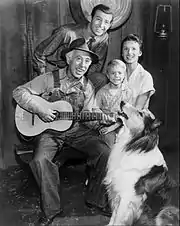 From left to right - George Chandler (as Uncle Petrie), Jon Shepodd (the original Paul Martin), Jon Provost (as Timmy Martin) and Cloris Leachman (the original Ruth Martin) during season 4 when the show transitioned from the Millers to the Martins.
From left to right - George Chandler (as Uncle Petrie), Jon Shepodd (the original Paul Martin), Jon Provost (as Timmy Martin) and Cloris Leachman (the original Ruth Martin) during season 4 when the show transitioned from the Millers to the Martins. Hugh Reilly and June Lockhart would take over as Paul and Ruth Martin from 1958-1964 (seasons 5-10)
Hugh Reilly and June Lockhart would take over as Paul and Ruth Martin from 1958-1964 (seasons 5-10)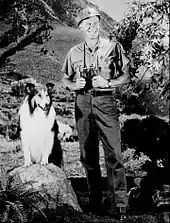 After 10 seasons on the farm with the Millers and the Martins, the series shifted to Lassie's adventures with the U.S. Forest Service during seasons 11-16, the bulk of that time featuring Robert Bray as Ranger Corey Stuart.
After 10 seasons on the farm with the Millers and the Martins, the series shifted to Lassie's adventures with the U.S. Forest Service during seasons 11-16, the bulk of that time featuring Robert Bray as Ranger Corey Stuart. Season 17 - the final CBS season - saw Lassie on her own, getting into different adventures each week. In seasons 18 and 19 (with the series airing in syndication), Lassie settled in at the Holden Ranch to close out the show's run.
Season 17 - the final CBS season - saw Lassie on her own, getting into different adventures each week. In seasons 18 and 19 (with the series airing in syndication), Lassie settled in at the Holden Ranch to close out the show's run.
The first 10 seasons of the series saw Lassie living on a farm, first with the Miller family (Jeff, his mother Ellen, and her father George - who was called "Gramps" by Jeff). Season 4 saw the Millers taking in young orphan Timmy, who then lived with them on the farm, as well as the unexpected death of Gramps, (reflecting the real life death of actor George Cleveland, who played the character), and with that the Millers moved off the farm, but Timmy and Lassie would stay behind with his new foster parents, Paul and Ruth Martin, who also took over the farm. All 10 of the Miller/Martin farm seasons would for the most part focus on "boy and his dog" adventures with Jeff or Timmy getting involved in some sort of trouble, and Lassie eventually coming to the rescue.
Seasons 11–16 were the "Ranger years" of the series, as Lassie (because she was not able to go to Australia with the Martins when Paul got a job teaching agriculture there) was taken in by U.S. Forest Ranger Corey Stuart (who appeared in a few episodes of season 10) and began to work with the U.S. Forest Service.[7] Color filming was exploited during the Ranger years with Lassie and her friends sent to exotic locations such as Sequoia National Forest and Monument Valley, creating miniature travelogues for viewers. Other rangers would be featured during the latter part of this era when Robert Bray (who played Stuart) left the series.[8]
For season 17, the program shifted gears again and became essentially an anthology series, with Lassie traveling on her own, getting into different adventures each week (similar in format to The Littlest Hobo and, later, to Here's Boomer). No explanation was given as to why Lassie was no longer with the Forest Service.[9] Some episodes during this final CBS season were animals only.
During seasons 18 and 19 (with the series having moved to first run syndication), Lassie was taken in by Garth Holden (played by Ron Hayes) who was in charge of the Holden Ranch – a home for orphaned boys – which he ran with his college-age son and his friend. This (somewhat) brought the show back to its roots by giving Lassie a farm/ranch home base, which is where she settled in for the final two years of the series.[10][11]
Episodes
| Season | Setting | Episodes | Originally aired | |||
|---|---|---|---|---|---|---|
| First aired | Last aired | Network | ||||
| 1 | Miller years (Jeff's Collie) | 26 | September 12, 1954 | March 6, 1955 | CBS | |
| 2 | 39 | September 11, 1955 | June 3, 1956 | |||
| 3 | 38 | September 9, 1956 | May 26, 1957 | |||
| 4 | Martin years (Timmy & Lassie) | 40 | September 8, 1957 | June 8, 1958 | ||
| 5 | 39 | September 7, 1958 | May 31, 1959 | |||
| 6 | 37 | September 6, 1959 | May 22, 1960 | |||
| 7 | 36 | September 11, 1960 | May 28, 1961 | |||
| 8 | 36 | September 10, 1961 | May 27, 1962 | |||
| 9 | 32 | September 30, 1962 | May 19, 1963 | |||
| 10 | 29 | September 29, 1963 | May 3, 1964 | |||
| 11 | Ranger years | 33 | September 6, 1964 | May 16, 1965 | ||
| 12 | 32 | September 12, 1965 | May 1, 1966 | |||
| 13 | 30 | September 11, 1966 | April 30, 1967 | |||
| 14 | 28 | September 10, 1967 | March 24, 1968 | |||
| 15 | 28 | September 29, 1968 | April 13, 1969 | |||
| 16 | 22 | September 28, 1969 | March 8, 1970 | |||
| 17 | On her own | 22 | September 20, 1970 | March 21, 1971 | ||
| 18 | Holden Ranch years | 20 | October 7, 1971 | March 10, 1972 | Syndication | |
| 19 | 24 | September 16, 1972 | March 24, 1973 | |||
Characters and cast
Human leads
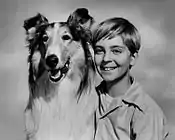
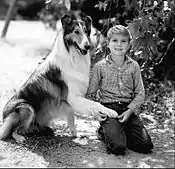
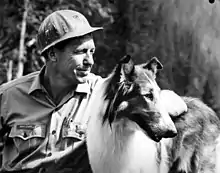
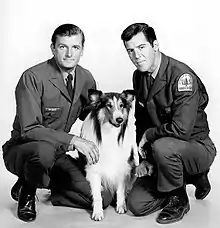
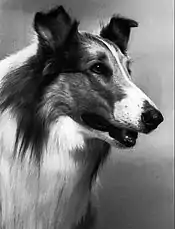
1954–1957: Miller Family (Jeff's Collie)
- Ellen Miller – war-widowed farm woman (Jan Clayton)
- Jeff Miller – Ellen's eleven-year-old son (Tommy Rettig)
- George "Gramps" Miller – Ellen's father-in-law and Jeff's paternal grandfather (George Cleveland)
- Sylvester "Porky" Brockway – a farm boy and Jeff's friend (Joey D. Vieira – using the stage name "Donald Keeler")
- Constable Clay Horton – the sheriff (Richard Garland)
1957–1964: Martin Family (Timmy & Lassie)
- Timmy Martin – a foster boy on the Miller farm (Jon Provost)
- Paul Martin – a young farmer, Ruth's husband and Timmy's adoptive father (Jon Shepodd 1957–1958; Hugh Reilly 1958–1964)
- Ruth Martin – Paul's wife and Timmy's adoptive mother (Cloris Leachman 1957–1958; June Lockhart 1958–1964)
- Petrie J. Martin – Paul's uncle (George Chandler) (1957–1959)
- Cully Wilson – a neighbor of the Martins, who was a farmer and nature lover (Andy Clyde) (1959–1964)
- Ralph "Boomer" Bates – a neighbor of the Martins who owned a dog named Mike and was Timmy's best friend (Todd Ferrell) (1958–1959)
- Scott Richards, another of Timmy's friends (Kelly Junge Jr.) (1958)
1964–1970: U.S. Forest Service
- Forest Ranger Corey Stuart (Robert Bray) (1964–1968)
- Assistant Forest Ranger Hank Whitfield (Clyde Howdy)[12][13] (1964–1966)
- Forest Ranger Bob Erickson (Jack De Mave) (1968–1970)
- Forest Ranger Scott Turner (Jed Allan) (1968–1970)
1970–1971: Traveling on her own
- No human leads
1971–1973: Holden Ranch
- Garth Holden – director of the Holden Ranch (Ron Hayes)
- Ron Holden – Garth's son (Skip Burton)
- Dale Mitchell – Ron's friend (Larry Wilcox)
- Keith Holden – Garth's brother (Larry Pennell)
- Lucy Baker – a deaf child living near the Holden Ranch (Pamelyn Ferdin)
Dog actors as Lassie
- Pal (Pilot episodes)
- Lassie Junior (1954–1959)
- Spook (1960)
- Baby (1960–1966)
- Mire (1966–1971)
- Hey Hey (1971–1973)
Media information
Broadcast history
First-run Lassie was televised September 12, 1954 to March 24, 1973 with its first 17 seasons airing on CBS Sundays at 7:00 p.m. EST. In 1971, in order to promote community-related programming among local affiliates, the Federal Communications Commission moved primetime Sundays to 8:00 P.M. EST with the institution of the Prime Time Access Rule. CBS executives felt Lassie would not be well received in a time slot other than its traditional 7:00 p.m. slot, and, with the network's other family programs set, the show was canceled.[11] (Lassie was among several shows that CBS canceled during this time period as part of a change in its target demographics.) Lassie then entered first-run syndication with Jack Wrather and Campbell's Soup still on board, and remained on the air for another two years with its final episode airing in March 1973. All totaled, 591 episodes were produced.
An animated reworking, Lassie's Rescue Rangers, followed in fall 1973, immediately after the original series ended (the pilot movie aired in 1972 while the live-action series was still on the air). Lassie's Rescue Rangers was denounced by both Weatherwax and the National Association of Broadcasters, the latter of which made note of the animated series' "violence, crime and stupidity."[14]
Later series
In 1973, ABC created an animated Saturday-morning animated program called Lassie's Rescue Rangers produced by Filmation.[11]
In 1989, what was essentially a sequel series, The New Lassie – featuring Jon Provost as Steve McCullough – aired in first-run syndication. In its seventh episode ("Roots"), June Lockhart reprised her Ruth Martin role when Steve McCullough is revealed to be the adult Timmy Martin. It is revealed that Timmy was never properly adopted by the Martins and consequently was forced to remain in the U.S. when Ruth and Paul emigrated to Australia. Timmy was then subsequently adopted by the McCullough family and began going by his middle name Steven. In 1992, Tommy Rettig made a guest appearance in the final episode, "The Computer Study". This would be his last television appearance prior to his death in 1996.[15]
In 1997, a modified remake – also called Lassie – debuted, airing in the U.S. on the then new Animal Planet cable network. This show (which was filmed in Canada and set in Vermont) also revolved around a boy named Timmy and his dog, though differences in setting and character circumstances precluded it from being an exact remake of the original series.[16]
DVD releases
The series was released to DVD between 2001–2007.
| DVD Name | # Ep | Release Date |
|---|---|---|
| Lassie's Great Adventure | 5 | June 26, 2001 |
| Lassie: Best of the Lassie Show | 3 | November 25, 2003 |
| Lassie: Lassie's Christmas Stories | 3 | November 25, 2003 |
| Lassie: Best of Jeff's Collie | 3 | November 25, 2003 |
| Lassie: Lassie's Birthday Surprise | 3 | November 25, 2003 |
| Lassie: Lassie's Gift of Love | 3 | November 25, 2003 |
| Lassie: 50th Anniversary Collection | 24 | September 14, 2004 |
| Lassie: Flight of the Cougar | 3 | March 6, 2006 |
| Lassie: A Mother's Love | 4 | May 1, 2007 |
| Lassie's Greatest Adventures Collection | 18 | September 17, 2019 |
Comics
The TV series was adapted into a comic book by Dan Spiegle, distributed by Gold Key Comics.[17]
Reception
Ratings
Every year of its 17-year run on CBS, Lassie placed first in its time slot, Sunday 7:00 P.M. EST, and often ranked among the top 25 shows on television. The show's highest ranking years in the Nielsen ratings were the Martin years when the show placed #24 in 1957, #22 in 1958, #15 in 1959, #15 in 1961, #21 in 1962, #13 in 1963, and #17 in 1964. The only Martin year Lassie did not climb into the top twenty-five was 1960, when it ran opposite Walt Disney Presents on ABC and Shirley Temple Theater on NBC.[18] However, Lassie still ran opposite Disney when the Disney anthology television series moved to NBC in 1961, and still managed to climb into the Top 25. With the advent of the Forest Service seasons, the show began a steady decline in ratings.[19]
| Season | Rank |
|---|---|
| 1954–1955 | Not in the Top 30 |
| 1955–1956 | |
| 1956–1957 | #24 |
| 1957–1958 | #22 |
| 1958–1959 | Not in the Top 30 |
| 1959–1960 | #29 |
| 1960–1961 | Not in the Top 30 |
| 1961–1962 | #15 |
| 1962–1963 | #19 |
| 1963–1964 | #12 |
| 1964–1965 | #17 |
| 1965–1966 | #27 |
| 1966–1967 | #33 |
| 1967–1968 | #30 |
| 1968–1969 | Not in the Top 30 |
| 1969–1970 | |
| 1970–1971 |
Awards and honors
(All awards listed given during the time of, or specifically related to the TV series)
- Two-time Emmy Award winner for Best Children's Program (1955, 1956)[20]
- 1956 Peabody Award[21]
- Three stars on the Hollywood Walk of Fame (Lassie – 1960, June Lockhart – 1960 for television, Jon Provost – 1994)
- 1967 U.S. Department of Agriculture Conservation Award (awarded to Lassie for promoting conservation during the series' Forest Service era)[22]
- Timmy Martin's shirt, jeans, and Keds displayed at the Smithsonian Institution
Cultural impact
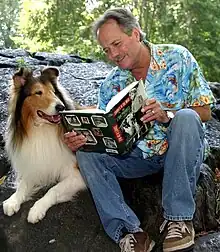
Jon Provost called his autobiography Timmy's in the Well! because a well was the one place Timmy never fell into—abandoned mine shafts, off cliffs, into rivers, lakes, and quicksand, but never a well.[23][24]
Mad parodied the show as "Lizzy", where it was revealed that the collie was actually a circus midget in a dog suit, while the real Lizzy was a dimwitted mutt. In an episode of The Flintstones ("Dino Goes Hollyrock"), the character Dino wins an appearance on the smash hit TV show "Sassie" starring a heavily made-up and snobby girl dinosaur and her Lassie-like adventures.[25]
Belgian comics artist Willy Vandersteen created his own version of the TV show with a collie named Bessy in 1954. Apart from the fact that his comic strip starred the same dog breed with a similar name, it had little to do with the series overall, since the comic was a Western comic.
References
- Notes
- Footnotes
- "Wrather narration". Lassie Web. Retrieved 2014-07-26.
- Catalog of Copyright Entries. Third Series. Vol. 8, Part 2, Number 1. The Library of Congress. January–June 1954. p. 43.
- Jensen, Steve. "Eric Freiwald". Retrieved 2020-07-13.
- Lassie /Jeffs Collie /Timmy and Lassie
- Burlingame, Jon (March 3, 2010). "Nathan Scott, 94, scored TV shows – Composer's credits included 'Dragnet,' 'Lassie'". Variety. Reed Business Information. Retrieved March 10, 2010.
- McClellan, Dennis (March 4, 2010). "Nathan Scott dies at 94; film and TV composer, arranger and conductor". Los Angeles Times. Retrieved March 13, 2010.
- "Lassie season 11". Lassie Web. Retrieved 2014-03-23.
- "Lassie season 15". Lassie Web. Retrieved 2014-03-23.
- "Lassie season 17". Lassie Web. Retrieved 2014-03-23.
- "Lassie season 18". Lassie Web. Retrieved 2014-03-23.
- Collins:
- "Clyde Houdeshell Dies". The Signal. Santa Clarita, California. October 8, 1969. p. 15. Retrieved July 15, 2022 – via Newspapers.com.

- Scott Freese, Gene (April 10, 2014). Hollywood Stunt Performers, 1910s-1970s: A Biographical Dictionary, 2d ed. McFarland. pp. 134–135. ISBN 9780786476435 – via Google Books.
- Erickson, Hal (2005). Television Cartoon Shows: An Illustrated Encyclopedia, 1949 Through 2003 (2nd ed.). McFarland & Co. pp. 487–488. ISBN 978-1476665993.
- "Tommy Rettig". IMDb. Amazon. Retrieved May 9, 2010.
- "Filming locations for "Lassie" (1997)". IMDb. Amazon. Retrieved May 9, 2010.
- "Dan Spiegle".
- Collins 1993, p.166
- Jenkins
- CBS at 75
- Peabody
- "Lassie Awards". Lassie.net. Archived from the original on 2013-07-14. Retrieved 2014-03-23.
- Provost:
- Thriving Canine Radio
- "Flintstones' Lassie takeoff". Fandango.com. Archived from the original on 2014-02-02. Retrieved 2014-06-21.
- Works cited
- Barron, James (September 16, 2004). "At Lunch With June Lockhart, Jon Provost and Lassie". The New York Times. Retrieved April 4, 2009.
- "CBS at 75: 1950s". CBS. Archived from the original on May 5, 2006. Retrieved February 22, 2008.
- Collins, Ace (1993). Lassie: A Dog's Life. New York: Penguin Books. ISBN 978-0-14-023183-0.
- "Hollywood Walk of Fame: MP". Hollywood Chamber of Commerce. Retrieved February 14, 2008.
- Jenkins, Henry. "Lassie". Museum of Broadcast Communications. Retrieved April 25, 2008.
- "Jon Provost's Keds sneakers". Smithsonian Institution.
- "Lassie (History timeline)". Classic Media. 2005. Archived from the original on August 13, 2006. Retrieved October 29, 2007.
- "Lassie /Jeffs Collie /Timmy and Lassie". ClassicThemes.com. The Media Management Group. Retrieved February 16, 2008.
- "Peabody Winners Book" (PDF). Peabody Awards. Archived from the original (PDF) on 2011-07-26. Retrieved 2008-02-14.
- Provost, John (November 2007). Timmy's in the Well. Cumberland House Publishing. ISBN 978-1-58182-619-7.
- Director: Alan Cooke, Writer: Bud Wiser (1989-10-21). "Roots". The New Lassie. Season 1. Episode 7.
- Stevens, Val (February 9, 1964). "News of TV and Radio" (PDF). The New York Times. Retrieved 2009-11-03.
- Bibliography
- Jenkins, Henry (2007). "'Her Suffering Aristocratic Majesty': The Sentimental Value of Lassie". The WOW Climax: Tracing the Emotional Impact of Popular Culture. New York University Press. ISBN 978-0-8147-4282-2.
- "Lassie ... My Best Friend". Jack and Jill. November 1959.
- "The Life and Times of Lassie". TV Guide. July 4, 1959.
- "The Man with Dog Appeal". TV Guide. August 14, 1965.
External links
- Lassie's official website Archived 2012-12-05 at archive.today
- Lassie's Twitter page
- Lassie at IMDb
| Preceded by Incumbent |
Lassie (CBS) alongside Walt Disney's Wonderful World of Color (NBC) Super Bowl lead-out program 1967 |
Succeeded by Lassie (CBS) 1968 |
| Preceded by Lassie (CBS) and Walt Disney's Wonderful World of Color (NBC) 1967 |
Lassie Super Bowl lead-out program 1968 |
Succeeded by Walt Disney's Wonderful World of Color 1969 |
| Preceded by Walt Disney's Wonderful World of Color 1969 |
Lassie Super Bowl lead-out program 1970 |
Succeeded by The Wonderful World of Disney 1971 |